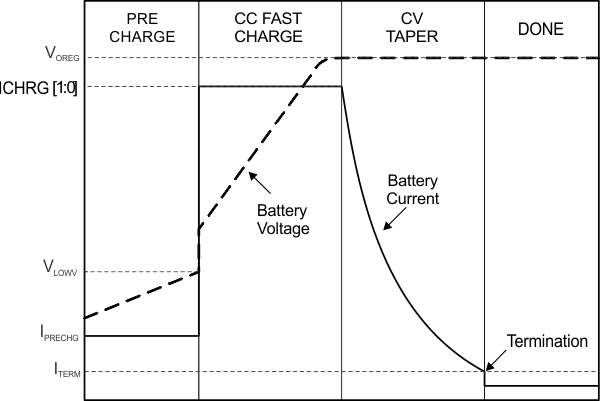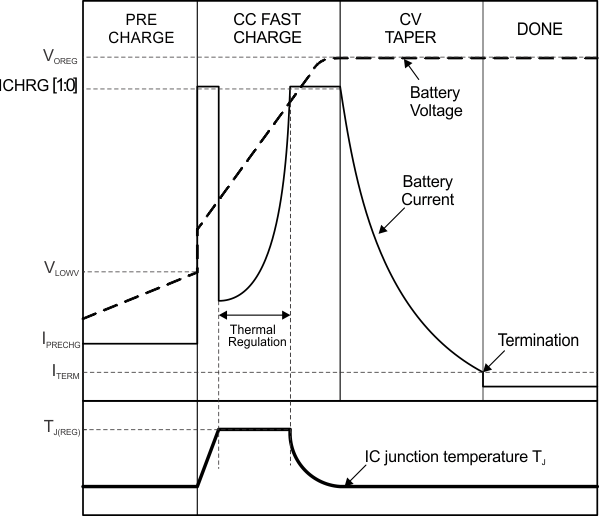ZHCSJX9 June 2019 TPS652170
PRODUCTION DATA.
- 1 特性
- 2 应用
- 3 说明
- 4 修订历史记录
- 5 Pin Configuration and Functions
- 6 Specifications
-
7 Detailed Description
- 7.1 Overview
- 7.2 Functional Block Diagram
- 7.3
Feature Description
- 7.3.1 Wake-Up and Power-Up Sequencing
- 7.3.2 Power Good
- 7.3.3 Push-Button Monitor (PB_IN)
- 7.3.4 nWAKEUP Pin (nWAKEUP)
- 7.3.5 Power Enable Pin (PWR_EN)
- 7.3.6 Reset Pin (nRESET)
- 7.3.7 Interrupt Pin (nINT)
- 7.3.8 Analog Multiplexer
- 7.3.9 Battery Charger and Power Path
- 7.3.10 Battery Charging
- 7.3.11 Precharge
- 7.3.12 Charge Termination
- 7.3.13 Battery Detection and Recharge
- 7.3.14 Safety Timer
- 7.3.15 Battery-Pack Temperature Monitoring
- 7.3.16 DC/DC Converters
- 7.3.17 Standby LDO Regulators (LDO1, LDO2)
- 7.3.18 Load Switches or LDO Regulators (LS1 or LDO3, LS2 or LDO4)
- 7.3.19 White LED Driver
- 7.4 Device Functional Modes
- 7.5 Programming
- 7.6
Register Maps
- 7.6.1 Register Address Map
- 7.6.2 Chip ID Register (CHIPID) (Address = 0x00) [reset = 0x02]
- 7.6.3 Power Path Control Register (PPATH) (Address = 0x01) [reset = 0x3D]
- 7.6.4 Interrupt Register (INT) (Address = 0x02) [reset = 0x80]
- 7.6.5 Charger Configuration Register 0 (CHGCONFIG0) (Address = 0x03) [reset = 0x00]
- 7.6.6 Charger Configuration Register 1 (CHGCONFIG1) (Address = 0x04) [reset = 0xB1]
- 7.6.7 Charger Configuration Register 2 (CHGCONFIG2) (Address = 0x05) [reset = 0x80]
- 7.6.8 Charger Configuration Register 3 (CHGCONFIG3) (Address = 0x06) [reset = 0xB2]
- 7.6.9 WLED Control Register 1 (WLEDCTRL1) (Address = 0x07) [reset = 0xB1]
- 7.6.10 WLED Control Register 2 (WLEDCTRL2) (Address = 0x08) [reset = 0x00]
- 7.6.11 MUX Control Register (MUXCTRL) (Address = 0x09) [reset = 0x00]
- 7.6.12 Status Register (STATUS) (Address = 0x0A) [reset = 0x00]
- 7.6.13 Password Register (PASSWORD) (Address = 0x0B) [reset = 0x00]
- 7.6.14 Power Good Register (PGOOD) (Address = 0x0C) [reset = 0x00]
- 7.6.15 Power-Good Control Register (DEFPG) (Address = 0x0D) [reset = 0x0C]
- 7.6.16 DCDC1 Control Register (DEFDCDC1) (Address = 0x0E) [reset = 0x18]
- 7.6.17 DCDC2 Control Register (DEFDCDC2) (Address = 0x0F) [reset = 0x08]
- 7.6.18 DCDC3 Control Register (DEFDCDC3) (Address = 0x10) [reset = 0x08]
- 7.6.19 Slew-Rate Control Register (DEFSLEW) (Address = 0x11) [reset = 0x06]
- 7.6.20 LDO1 Control Register (DEFLDO1) (Address = 0x12) [reset = 0x09]
- 7.6.21 LDO2 Control Register (DEFLDO2) (Address = 0x13) [reset = 0x38]
- 7.6.22 Load Switch1 or LDO3 Control Register (DEFLS1) (Address = 0x14) [reset = 0x26]
- 7.6.23 Load Switch2 or LDO4 Control Register (DEFLS2) (Address = 0x15) [reset = 0x3F]
- 7.6.24 Enable Register (ENABLE) (Address = 0x16) [reset = 0x00]
- 7.6.25 UVLO Control Register (DEFUVLO) (Address = 0x18) [reset = 0x00]
- 7.6.26 Sequencer Register 1 (SEQ1) (Address = 0x19) [reset = 0x00]
- 7.6.27 Sequencer Register 2 (SEQ2) (Address = 0x1A) [reset = 0x00]
- 7.6.28 Sequencer Register 3 (SEQ3) (Address = 0x1B) [reset = 0x00]
- 7.6.29 Sequencer Register 4 (SEQ4) (Address = 0x1C) [reset = 0x40]
- 7.6.30 Sequencer Register 5 (SEQ5) (Address = 0x1D) [reset = 0x20]
- 7.6.31 Sequencer Register 6 (SEQ6) (Address = 0x1E) [reset = 0x00]
- 8 Application and Implementation
- 9 Power Supply Recommendations
- 10Layout
- 11器件和文档支持
- 12机械、封装和可订购信息
封装选项
请参考 PDF 数据表获取器件具体的封装图。
机械数据 (封装 | 引脚)
- RSL|48
散热焊盘机械数据 (封装 | 引脚)
- RSL|48
订购信息
7.3.10 Battery Charging
When the charger is enabled (the CH_EN bit is set to 1b), it first checks for a short circuit on the BAT pin by sourcing a small current and monitoring the BAT voltage. If the voltage on the BAT pin increases to more than the BAT pin short-circuit detection threshold (VBAT(SC)), a battery is present and charging can start. The battery is charged in three phases: precharge, constant-current fast charge (current regulation), and constant-voltage (CV) charge (voltage regulation). In all charge phases, an internal control loop monitors the device junction temperature and decreases the charge current if an internal temperature threshold is exceeded. Figure 13 shows a typical charging profile. Figure 14 shows a modified charging profile.
 Figure 13. Charging Profiles—Typical Charge Current Profile With Termination Enabled
Figure 13. Charging Profiles—Typical Charge Current Profile With Termination Enabled  Figure 14. Charging Profiles—Modified Charging Profile With Thermal Regulation Loop Active and Termination Enabled
Figure 14. Charging Profiles—Modified Charging Profile With Thermal Regulation Loop Active and Termination Enabled In the precharge phase, the battery is charged at the precharge current (IPRECHG), which is typically 10% of the fast-charge current rate. The battery voltage starts rising. After the battery voltage crosses the precharge-to-fast-charge transition threshold (VLOWV), the battery is charged at the fast charge current (ICHG). The battery voltage continues to rise. When the battery voltage reaches the battery charger voltage (VOREG), the battery is held at a constant value of VOREG. The battery current now decreases as the battery approaches full charge. When the battery current reaches the charge current for termination detection threshold (ITERM), the TERMI bit in the CHGCONFIG0 register is set to 1b. To avoid false termination when the charger goes to either the dynamic power path management (DPPM) loop or thermal loop, termination is disabled when either loop is active.
The charge current cannot exceed the input current limit of the power path minus the load current on the SYS pin because the power-path manager decreases the charge current to support the system load if the input current limit is exceeded. Whenever the nominal charge current is decreased by action of the power-path manger, the DPPM loop, or the thermal loop, the safety timer is clocked with half the nominal frequency to extend the charging time by a factor of 2.